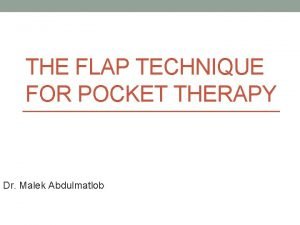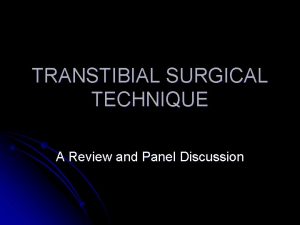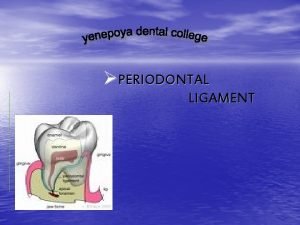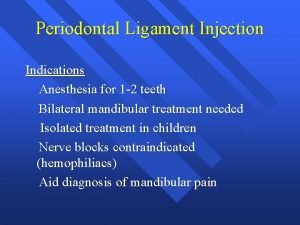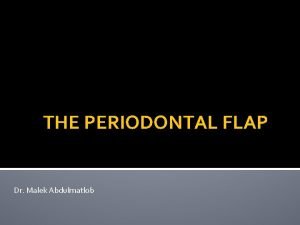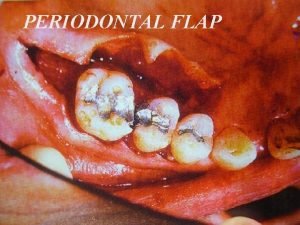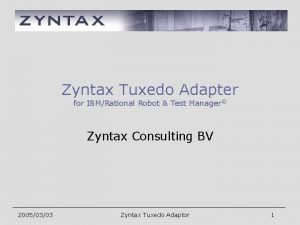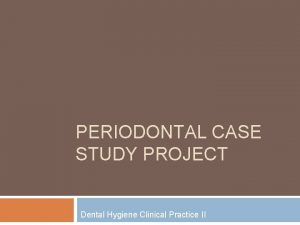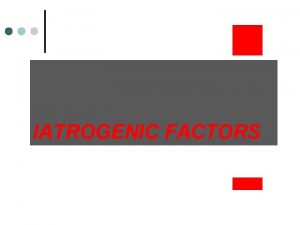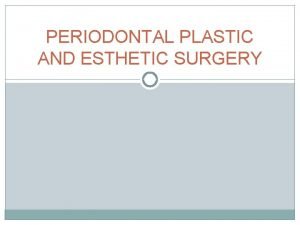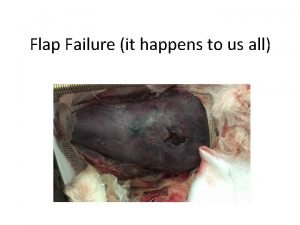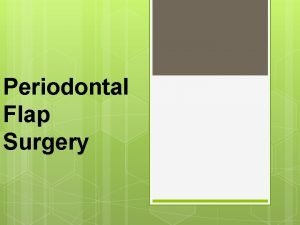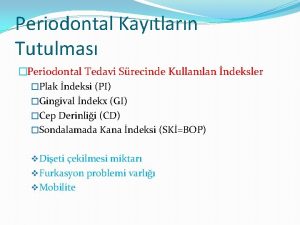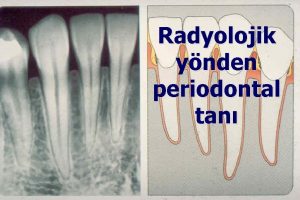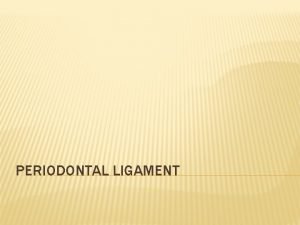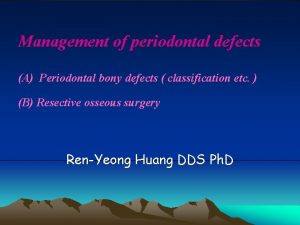THE PERIODONTAL FLAP Rational Indications and Techniques DEFINITION














- Slides: 14

THE PERIODONTAL FLAP Rational, Indications and Techniques

DEFINITION OF PERIODONTAL FLAP • Periodontal Flap is a section of gingiva and/or mucosa, surgically separated from the underlying tissues to provide visibility of and access to bone and root surfaces, such as those associated with deep pockets or furcations.

OBJECTIVES OF SURGICAL PROCEDURES • Improvement of the prognosis of teeth and their replacements. • Improvement of esthetics. • The surgical phase consists of various techniques that can be used for the pocket therapy and for the correction of related morphologic problems, namely mucogingival defects.

GOALS OF FLAP PROCEDURES • To expose root surfaces that are not accessible, such as those associated with deep pockets or furcations, in order to improve the efficiency of scaling and root planing. • The surgical reduction or elimination of the periodontal pocket (resective pocket surgery). • The induction of adaptation and new attachment and bone regeneration in periodontal pockets (regenerative pocket surgery). • The correction of gingival and mucogingival defects and deficiencies.

Pocket Reduction Surgery • Resective: gingivectomy, apically displaced flap and undisplaced flap with or without osseous resection. • Regenerative: flaps with grafts, guided tissue regeneration, and coronally positioned flaps.

Correction of Anatomic – Morphologic Defects • Plastic surgery techniques to widen attached gingiva: free gingival grafts, etc… • Esthetic surgery: root coverage, and re-creation of gingival papillae. • Preprosthetic techniques: crown lengthening, ridge augmentation, and vestibular deepening.

Basic Principles Of Flap Surgery Classification of flaps: 1. According to the thickness of the flap 2. According to placement of the flap. 3. According to the management of the interdental papilla.

1. According to the thickness of the flap Depending on whether bone is exposed or not, flaps can be classified as: • Full Thickness Flaps (Mucoperiosteal Flaps): All the soft tissues including the periosteum is reflected to expose the underlying bone. The procedure is indicated when resective osseous surgery is contemplated. • Partial or Split-Thickness Flaps (Mucosal Flaps): Reflection of only the epithelium and a layer of the underlying connective tissue, the bone remains covered by a layer of connective tissue including the periosteum. It is indicated when the flap is to be positioned apically or when the Dentist does not desire to expose bone.

2. According to the Placement of the Flap Based on the flap placement at the end of the procedure, flaps can be classified as: • Non-displaced flaps: When the flap is sutured in its original position (access flaps). • Displaced flaps: The flap is sutured in a more apical (apically positioned flap) or coronal position (coronally positioned flap) to its original position. Palatal flaps cannot be displaced.

3. According to the Management of the Papilla Flaps can be conventional or papilla preservation flaps: • Conventional Flaps: splitting the papilla into facial half and lingual or palatal half. Conventional flaps include modified Widman flap, the undisplaced flap and apically displaced flap. The conventional flap is used when: • The interdental spaces are too narrow to permit the preservation of the papilla. • When there is a need for displaced flaps. • Papilla Preservation Flaps: entire papilla is incorporated into one of the flaps.

INCISIONS • Horizontal Incisions: are made along the gingival margin either laterally to the margin (internal bevel incision) or in the pocket (crevicular incision): A. Internal bevel incision = reverse bevel incision: Is the basic incision allowing the flap to be reflected to expose the root and alveolar bone. It starts at a distance of 0. 5 -1 mm from the gingival margin and extends full depth to the alveolar bone.

INCISIONS B. Crevicular Incision (intrasulcular incision): Is the second incision that will enable with the first internal bevel incision the removal of the part of gingival tissue located in between the two horizontal incisions.

INCISIONS C. Interdental incision: Is the third incision (Orban knife is usually utilized for this incision) that is done after slight elevation of the flap with a periosteal elevator introduced in the internal bevel incision line.

INCISIONS • Vertical incisions: • Vertical or oblique releasing incision can be used at one or both ends of the horizontal incision. • If the flap needs to be displaced, the incision(s) needs to extend beyond the muco-gingival line. • Incision(s) should be made at the line angle of a tooth to avoid incising over the root or the papilla.
 Conventional flap surgery
Conventional flap surgery Skewed flap
Skewed flap Rational equation and rational inequalities
Rational equation and rational inequalities Thixotropic theory of pdl
Thixotropic theory of pdl Thixotropic theory of pdl
Thixotropic theory of pdl Periodontal ligament injection definition
Periodontal ligament injection definition Corrective phase periodontal therapy
Corrective phase periodontal therapy Flap reflection definition
Flap reflection definition Modified widman flap
Modified widman flap Tux robot
Tux robot Principles of scaling and root planing
Principles of scaling and root planing Perimylolysis
Perimylolysis Politür patı
Politür patı Eoe ioe dental
Eoe ioe dental Iatrogenic factors in periodontal disease
Iatrogenic factors in periodontal disease
